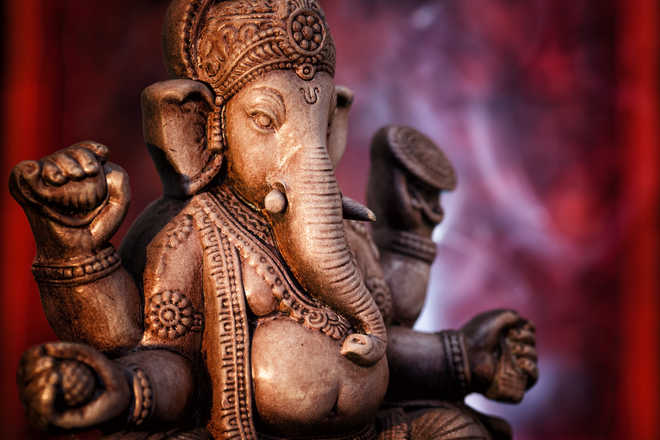Dr Satish K Kapoor
Shri Ganesha, known by 1008 or more names, such as Ganapati, lord of troupes; Gajanana, elephant-faced; Lambodara, having big belly; Ekadanta, one-tusked; Vakratunda, with twisted trunk; Shurpakarna, with broad ears; Siddhidata, giver of perfection; Vinayaka or Vighneshvara, removal of obstacles etc, is the most popular deity, invoked at the beginning of an auspicious ceremony, ritual, or an undertaking, whether sacred or secular.
Establishing Shri Ganesha in a temple or home-shrine, is enshrining the truth. In south India, he is recognised as Pillaiyar, and is usually placed in the centre in panchayatana puja involving the worship of five deities. His multiple forms remind one of the Rigvedic phrase– tvam hi satyo adbhuta — ‘Thou art truth wonderful.’
Shri Ganapati Atharva Shirsha, written on the doorway to Ranjangaon Maha Ganapati temple in Maharashtra, identifies him with Brahman, the supreme self. He is the lord of gods and created beings, without any equal or superior, beyond illusion and reality. He transcends all the three forms of body — sthula (gross), sukshma
(subtle) and karana (causal) and represents the four forms of speech – para, pashyanti, madhyama, and vaikhari. He is the god of wisdom, health, beauty, literature, fine arts, trade, science and skills.
When Veda Vyasa asked him to act as his scribe for writing the epic Mahabharata he put forth the condition that the sage should not stop giving dictation till the work was complete. In turn, he was directed not to write without understanding the meaning of each verse. He completed the job with the broken part of his tusk.
Divinity is best expressed through symbols. Each part of the body of Shri Ganesha has subtle meaning or message. His elephant-head represents power and intelligence. His trunk is the symbol of agility and virility. His tiny but steady eyes indicate poise and foresight and his long nose, prestige and positivity. His small mouth and large ears instruct that one should speak less and hear more. His single tusk refers to one-pointedness in life. His ears, like winnowing baskets, sift the good from the bad. His protruding belly contains the whole universe. He can see the past and the future with his third eye.
In sculptures, paintings, drawings and other exhibits of Shri Ganesha found all over India and in Western and South East Asian countries, the Lord is usually shown with four arms but is sometime depicted with less or more. He holds several articles in his hands like ankusha
(goad), pasha (noose), trishula (trident), ratna-kumbha (pot of jewels), kamandalu (water vessel), shankha (conch), vina (stringed musical instrument), a bouquet of flowers, coconut, pomegranate, a sugarcane stalk, blue lotus, modaka, sweet dish, etc., all of which reveal his attitude, affluence, aesthetic sense, religious sensibility, and power to curb devilish forces. He gives protection and blessings with his hand-postures — abhaya mudra and varada mudra.
Shri Ganesha is generally regarded as a celibate. Yet, symbolically, Riddhi and Siddhi, fortune and accomplishment, are said to be his consorts; Kshema and Labha, safety and profit, his sons; and Santoshi Ma, the mother contentment, his daughter.
He is the presiding deity of the four-petalled muladhara chakra at the base of spine, where lies the kundalini or serpent-power. His graphic presentation in the form of swastika, denotes auspiciousness. Aum (om; pranava) is his sound-symbol, and he is invoked by its chant. His squatting posture is said to represent a; his belly, u, and his forehead, m.
The three most popular mantra-s used in his worship are: Om gam ganapataye namah; Om Shri Ganeshaya namah and Om gam om. These sound syllables create vibrations similar to his form. Gam is the bija-mantra, seed-sound, of Shri Ganesha, who represents the earth element, just as ram represents the fire element, ham the ether element, vam the water element, and yam the air element.
Shri Ganesha-yantra-s are written on the bark of bhojapatra (Betula utilis), metal, wood, paper, clay, cloth, stone, or other material, or drawn on gateways, walls or floors in rangoli-designs, for beauty, beatitude, celebration or worship.
Shri Ganesha is easily pleased with the offerings of durva-grass, leaves of plants and trees like akka, dhatura, apamarga, shami, and bilva, red or blue flowers, baked rice-balls, modaka-s of sesamum seeds and ladoos, sweet balls, specially on Chaturthi-s, fourths of a lunar month – sankashti in dark fortnight and vinayaka in bright fortnight.
Ganesha visarjana, immersion of the clay images of Shri Ganesha, is made ten days after the most propitious chaturthi celebrations, starting from the bright fourth of Bhadrapada
(August-September). It is a spiritual voyage of devotees from the divine forms and symbols of Shri Ganesha to the formless Reality.
( Dr Satish K Kapoor, former British Council Scholar and former Registrar, DAV University is a noted author, educationist, historian and spiritualist based in Jalandhar City)
Unlock Exclusive Insights with The Tribune Premium
Take your experience further with Premium access.
Thought-provoking Opinions, Expert Analysis, In-depth Insights and other Member Only Benefits
Already a Member? Sign In Now











